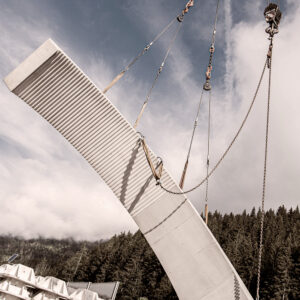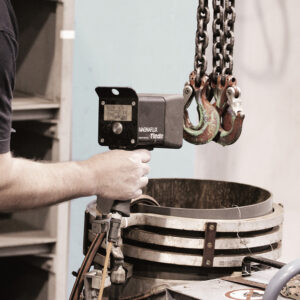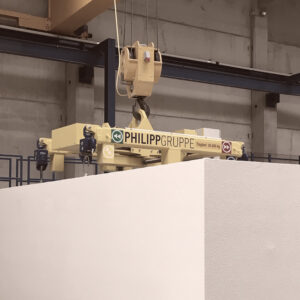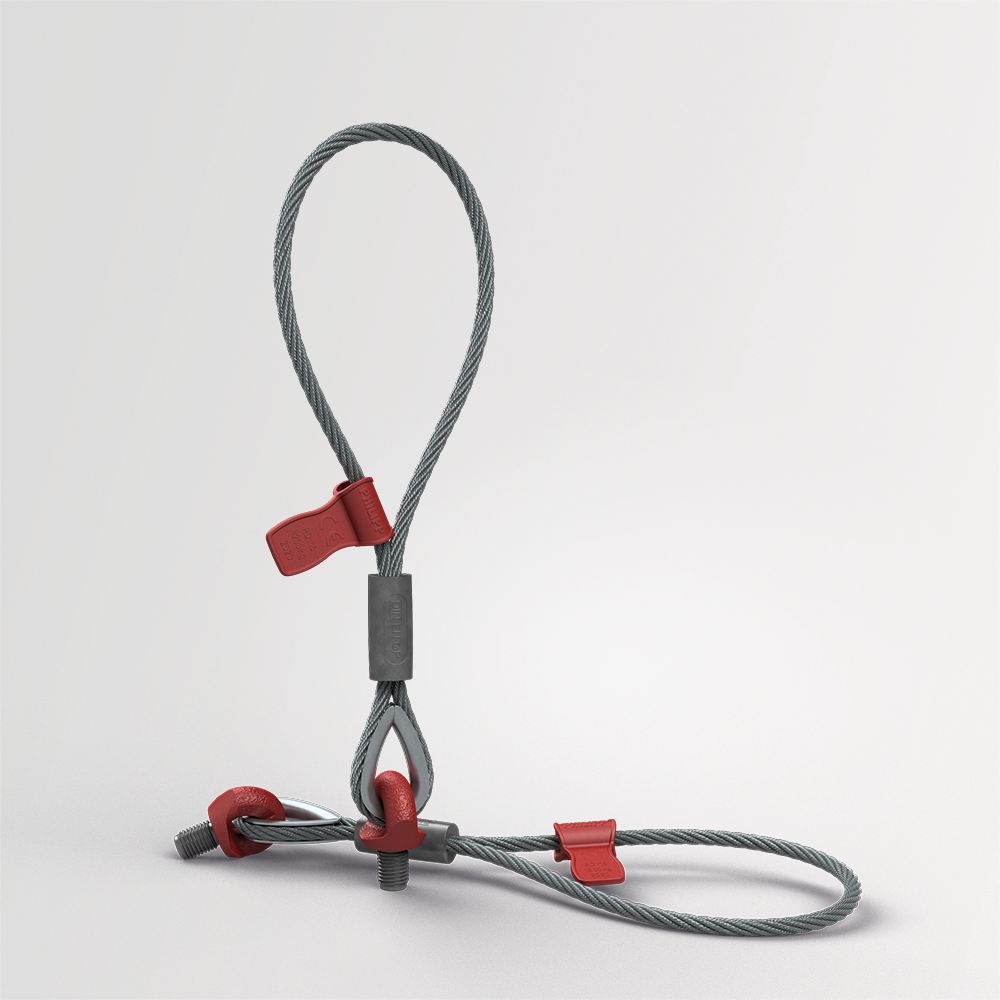The Lifty DS is a universally applicable lifting device for the PHILIPP threaded anchor system. It consists of a forged ring pin with thread and a pressed-in solid wire rope in galvanized design.

The Lifty DS is a universally applicable lifting device for the PHILIPP threaded anchor system. It consists of a forged ring pin with thread and a pressed-in solid wire rope in galvanized design.
The Lifty DS is a universally applicable lifting device for the PHILIPP threaded anchor system. It consists of a forged ring pin with thread and a pressed-in solid wire rope in galvanized design.
In Europe, transport anchors are regulated as lifting accessories in the Machinery Directive and, from 2027, in the new Machinery Regulation. Safety requirements for such “machines” and working coefficients (safety factors) are defined here, i. e. factors for achieving an appropriate level of safety for metallic components and other materials.
EN 13155, which is harmonised in Europe, also applies to the actual manufacture of transport anchors. In Germany, planning, design and application are regulated by the VDI/BV-BS 6205 guideline. In the rest of Europe, either this guideline or CEN/TR 15728 can be followed. A product standard or approval for transport anchors does not exist.
If transport anchors and lifting devices verifiably fulfil the requirements of the Machinery Directive resp. Regulation regarding steel bearing capacity, they shall be marked with a CE. In addition, the manufacturer has to provide a Declaration of Conformity (DoC) for the transport anchor or the lifting device in which those requirements are confirmed.
The Eurocode 2 refers to existing product standards with regard to the manufacture and mounting of specific precast elements.
In general, “transient situations” shall be taken into account when designing and constructing precast elements in accordance with Eurocode 2. Among others, these include transport and mounting of the precast elements.
This means that the planner is responsible for the design of transport anchors in accordance with Eurocode 2 and, if applicable, the country-specific National Annex and other standards (in Germany DIN 1045-1000).
However, with the help of guidelines, manufacturers’ instructions and if so further services the planner is able to do a complete design of transport anchors.
Years ago, the DIBt in Germany (highest approval and assessment body) confirmed that “Anchors that are used exclusively for the transport (for lifting) of prefabricated (reinforced) concrete parts (transport anchors) are not construction products within the meaning of public building law. For transport anchors a proof of usability in the form of a technical approval is therefore not required.”.
The manufacturing of transport anchors is regulated in the harmonised standard EN 13155, the design and application in the German VDI/BV-BS 6205 or CEN/TR 15728.
A transport anchor system always consists of the actual anchor set in concrete and the belonging lifting device from one manufacturer.
Generally, the transport anchor and the corresponding lifting device can be assigned by means of the marking, the colouring and/or the shape of the recess in the concrete element.
In principle, lifting devices intended for the transport of precast concrete elements shall always be used. Similar devices (e. g. eyebolts) must not be used.
Lifting ropes or chains including hooks (so-called lifting accessory) and crane ropes including hooks (so-called load carrying device) complete the lifting equipment in this context.
The PHILIPP Threaded transport anchor system consists of a combination of various transport anchor types with a socket (female thread) and corresponding lifting devices with a thread (male thread). Both system components are offered with metric round (RD) or metric (M) thread.
The combination does not lead to a reduction of the load-bearing capacity. In general, this applies to all types of threaded sockets.
Please note that the combination of RD external thread and M internal thread is not possible.
There is no repeated use of transport anchors if they are only used within the transport chain, i. e. from the manufacture of a precast element to installation on the construction site. In this case, transport anchors can be made of any (steel) material.
If concrete elements (e. g. cover slabs, crane ballasts) are lifted again after the initial installation, anchors must be made of an approved stainless steel due to repeated usage.
The most important parameters in the design of transport anchors are:
Before and during the design the following important steps have to be done by the planner:
Detailed information can be found in the General Installation and Application Instruction.
Subsequent welding on PHILIPP lifting anchors is generally not permitted.
Welding is only permitted by the manufacturer acc. to the rule German of the Employer’s Liability Insurance (DGUV 101-001).
Possible material embrittlement, internal stresses, etc. cannot be prevented by repeated heating (e. g. by welding processes) and thus welding on lifting anchors is generally not recommended.
The German VDI/BV-BS 6205 guideline also deals with welding but only on the reinforcing steel belonging to a transport anchor and only under certain conditions. Generally, weld spots to fix the anchor to the reinforcement nearby are not considered as critical.
Modifications of any kind to transport anchors are generally not permitted.
The shape and dimensions of the transport anchors are generally based on calculations and related tests. The load-bearing capacities are derived from these, taking safety factors into account.
Manipulations in the form of bending, shortening or welding reduce the load-bearing capacity of a transport anchor in an unforeseeable way and thus represent a potential risk within the entire transport chain of a precast concrete element.
EN 13155, the standard which applies to the manufacture of transport anchor systems, sets high safety requirements and states the obligation to design and mark these systems in such a way that a clear assignment of compatible transport anchors and lifting devices is guaranteed.
The VDI/BV-BS 6205 guideline completes this requirement by stating that a compatibility across manufacturers of transport anchors and lifting devices shall be strived for and proven by the manufacturers. Such proof of compatibility is very time-consuming and costly for all manufacturers and is not very practical.
The German employers' liability insurance association specifies binding requirements for the inspection of lifting devices (DGUV 109-017, section 8). This must be carried out at least once a year by an authorised person. This can be a qualified person from your own company or an external third party (e. g. PHILIPP).
Depending on the conditions of use or for justified reasons, inspections may also be required at shorter intervals or on an exceptional basis.
However, in addition to the official inspection requirements, it should always be in the interest of every user of lifting devices to do a visual inspection before each use in order to protect themselves and their colleagues from potential risks.
The German VDI/BV-BS guideline states: “
Lifting inserts which have been used improperly during load securing or which have been subjected to exceptional loads, e.g. due to load slippage, must no longer be used to transport the precast concrete part.“.
Therefore, we recommend to use additional transport anchors only for load securing and to label them clearly on the precast element.
For each application, transport or load securing, appropriate verifications shall be provided.
Even though the mechanisms of action of transport and permanent anchors are very similar, the normative and technical background is completely different.
Anchors for the permanent fixing of any construction are safety-relevant construction products and must be approved as there is currently no product standard. Both, the specified test guidelines as well as the design are completely different compared to a transport anchor.
Thus, a lifting anchor must not be used for a permanent fixing, just as lifting a concrete element is forbidden with an anchor intended for a permanent fixing of constructions. Combining applications and thus saving on mounting parts is not possible with these product groups.
Nearly all transport anchors consist exclusively of metal parts, so that they can be sorted and recycled with the reinforcing steel without restriction when (precast) concrete elements are removed.
However, if complete precast elements are to be reused, installed transport anchors must no longer be used for lifting (exception: stainless steel transport anchors).
The PHILIPPGRUPPEis your competent partner for high-quality products in the fields of construction technology, rope and lifting technology and hydraulics.






